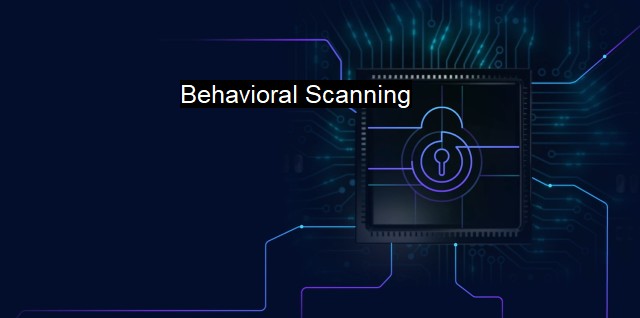What is Behavioral Scanning?
The Evolution of Cybersecurity: Understanding Behavioral Scanning and Its Role in Detecting Cyber Threats
Behavioral scanning is a critical aspect in cybersecurity and antivirus technology aimed at protecting information systems from potential threats. It is a sophisticated next-generation scanning technique employed to detect malware, based on the observation and scrutiny of how particular applications and codes act or behave.Behavioral scanning, often interchangeably referred to as behavioral detection or heuristic scanning, is an intelligent mechanism that observes the activity inside a program and on your computer system, tracking and cataloguing actions that might indicate a security threat. The process involves the monitoring and documenting in real-time of notably any unauthorized and suspicious activities, inconsistent from the usual trademarks and patterns of authorized, standard programs.
For an elaborate understanding, envision an investigative journalist naively digging for information to uncover potential fraud or unsolicited activities. Similarly, behavior-based security markers are trained to discern anomalies, validate the same against recorded safe behaviour metrics, pivot upon warranted actions, and ensure that treads on malicious grounds are swept out instantly.
Conventional antivirus scans depend on virus-definition databases for detection of threats. These are highly effective for combating known viruses but happen to fall short when encountering unidentified malware or advanced persistent threats, that are unbeknownst to them. Niche spyware, often-changing threat parameters & viruses that have shown a propensity to rapidly evolve, repeatedly validate the insufficiency of traditional methods. It is in these landscapes that behavioral scanning becomes the safe house. Technological enhancements over time have resulted in the rise of 'day-zero attacks', wherein fraudsters exploit unknown, unprotected vulnerabilities in the software. Behavioral scanning techniques have upended usage from not just being defensive but fending off these attacks at inception.
Behavioral scans do not just limit themselves to singular attacks but scan across a range of diverse security concerns including, hazardous changes to critical system files, suspect registry modifications, sinister launch points, clandestine remote connections among many others.
While this technique is relatively advanced, the entire behavioral identification approach isn't flawless and can lead to false alarms. Sometimes, legitimate actions performed on a machine may be flagged as suspicious because they may resemble markers ticking off a potentially harmful action. Thirty-party applications often trigger such false flags that the system might recognize as an intrusion leading to their blockage. Despite these, behavioral scanning provides a robust shield against the rapidly evolving spectrum of threats cybersecurity poses today.
To further enhance the accuracy and lower the number of false detections, companies globally are employing machine learning algorithms for intelligent threat detection. Leveraging artificial intelligence (AI), antivirus software can learn from each interaction, becoming smarter over time. Advanced behavioral scanning, aligned with AI, features capabilities to recognize deviations in accessing and using personal data, discerning preeminent viruses even in their sleep-mode, tracing the source of an under-attack, potential harmful activities, even when offline, etc, making it increasingly consensus building as the forward-path.
The inclusion of behavioral scanning is not intended to render traditional scanning techniques obsolete rather it complements them, helping bridge gaps that signature-based scanning may fail to identify, all this while maintaining system hygiene and promising a robust business infrastructure free and secure from harmful potential cybersecurity threats. Altogether, with the cybersecurity landscape continually evolving, this multi-pronged security architecture that includes behavioral scanning forms an imperative defence mechanism in the battle against our cyber adversaries.

Behavioral Scanning FAQs
What is behavioral scanning?
Behavioral scanning is a cybersecurity technique that analyzes the behavior of software and computer systems to detect potential threats. It involves monitoring the activity of programs and systems to identify any abnormal patterns or suspicious behavior that could indicate a virus or malware attack.How does behavioral scanning differ from traditional antivirus software?
Traditional antivirus software uses a signature-based approach to detect malware, which means it looks for specific patterns or signatures of known viruses. Behavioral scanning, on the other hand, is designed to be more proactive and can detect malware that has not yet been identified or cataloged. It does this by analyzing the behavior of software and systems, rather than just looking for specific virus signatures.What are the benefits of using behavioral scanning in cybersecurity?
There are several benefits to using behavioral scanning in cybersecurity. First, it can detect zero-day attacks, which are attacks that exploit vulnerabilities that have not yet been discovered or patched. Second, it can detect malware that has been modified or disguised to avoid detection by traditional antivirus software. Finally, it can provide a more comprehensive view of the overall security posture of a system by monitoring the behavior of all software and systems, rather than just a few specific applications.Is behavioral scanning effective against all types of cyber threats?
While behavioral scanning can be highly effective at detecting and preventing many types of cyber threats, it is not a silver bullet. There may be some sophisticated attacks or malware that can evade detection by behavioral scanning, just as there may be some malware that can evade traditional antivirus software. However, by using a combination of different security techniques, including behavioral scanning, organizations can significantly improve their overall cybersecurity posture and reduce the risk of cyber attacks.| | A | | | B | | | C | | | D | | | E | | | F | | | G | | | H | | | I | | | J | | | K | | | L | | | M | |
| | N | | | O | | | P | | | Q | | | R | | | S | | | T | | | U | | | V | | | W | | | X | | | Y | | | Z | |
| | 1 | | | 2 | | | 3 | | | 4 | | | 7 | | | 8 | | |||||||